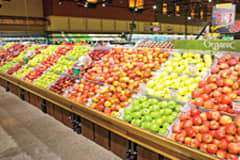When it comes to sharing America’s growing infatuation with fresh, local food, Wegmans Food Markets puts its money where its mouth is.

Source: Wegmans
Local apple display at Wegmans Market.
The regional grocery chain runs a fifty-acre research farm near New York’s Canandaigua Lake specializing in sustainable, organic growing practices. CEO Danny Wegman often blogs about the five-year-old farm, and in August 2012 he finally opened it to public tours.
Sure, the Wegmansfarm can only supply veggies to two nearby stores, but it serves as a living symbol for the privately owned chain of 80 mid-Atlantic supermarkets. Its mission: Local, healthy food aimed at everyday families. To reinforce the message further, the company web site gives shoppers a running schedule when local fruit and vegetables will arrive at stores in their state.
It turns out that local apples and squash carry a hefty economic wallop. While large food chains struggle with slow sales, Wegmans thrives.
In 2011, its revenue hit $5.60 billion, up 8.7 percent. And the fastest growing segment at Wegmans markets is organic — mostly local — produce. Sales of produce have swelled at least 10 percent every year for the last five years.
It’s not alone. On the national front, Whole Foods Market , the upscale natural and local-foods grocer, is doing just as well. It posted some of the best results in its 32-year history in the third quarter, ending July 1, 2012, with net income up 32 percent.
Love them or hate them, locavores have gone mainstream, shedding their elitist, niche image. Health advocates, doctors, and First Lady Michelle Obama are convincing Americans across income groups to eat more fresh fruit and vegetables. And fresh is increasingly interpreted to mean locally grown.
As a result, local foods sales are booming. They grew from $4 billion in 2002 to $5 billion in 2007 to $11 billion in 2011, according John Ikerd, University of Missouri agriculture economics professor emeritus. Three-quarters of specialty food retailers say that “local” is the most influential product claim in 2012, according to the National Association of the Specialty Food Trade.
Dept. of Agriculture data backs it up: retail sales of fresh produce averaged growth of 15 percent a year between 1997 and 2007, while sales of organic fruits and vegetables increased over fourfold from 1997 to 2008, to $21.1 billion in 2008. (Not all organic food is local.)
Why go local? Produce you buy at the grocery store typically travels more than 1,500 miles from farm to table, says Harvard Medical School’s Center for Health and the Global Environment. But a road less travelled could mean better nutrition.
Big And Small Winners
“Even with the best handling standards, fresh food that spends significant time on the road loses nutrients and flavor,” according to the center. (Food advocates usually define local as food grown up to 100 miles away; the federal government defines it as up to 400 miles away.)
Market for Farmers' Markets
Even the USDA has gotten into the local act with its"Know Your Farmer, Know Your Food" program, connecting consumers with nearby farmers' markets. “We strongly support local food systems as a way to address the challenges of obesity and hunger … which both stem from limited access to healthy food,” states Kathleen Merrigan, USDA deputy secretary on the site.
Indeed, more than 7,100 farmers' markets were operating in the U.S. at the end of 2011, a 20-percent increase over the year before, per the USDA. So it should be no surprise then that big discount and grocery chains want to get a slice of the local-food pie.

Source: Wegmans
The main building at Wegmans research farm.
Wal-Mart , for example, hopes to double sales of fresh produce from local farms in its US stores by the end of 2015 and is spending more than $1 billion globally to move fresh food to stores faster.
Safeway, a chain of 1,700 markets in the U.S. and Canada, is also revamping its "Lifestyle" format stores to give more space to organic selections and fresh produce.
Major retailers have a golden opportunity to woo local-food fans, say experts, but often it is young grassroots companies that are driving innovation.
Take Good Eggs Inc.in San Francisco, Calif., for example. Co-founders Alon Salant and Rob Spiro launched a web site in July 2012 that is a multi-purpose, user-friendly “storefront,” for people to buy food directly from farmers and vendors in the city.
Food is hand-delivered by vendors or available for pickup at neighborhood hangouts like shops and bookstores.
Many Good Eggs vendors are “full-time, small scale operations with $100,000 to $1 million in sales — and very slim profit margins,” said Spiro.
The startup hopes to expand to the greater San Francisco Bay Area, Detroit, Los Angeles, Brooklyn, NY and Portland, Ore.
Across the country, near downtown Beaufort, S.C., is the SILO-Beaufort market. Founded in July 2011, it offers a web site where local food producers list what they have to sell each week.
Registered buyers place their online orders and then go to the SILO market storefront on Friday evenings to pick up their food. Sales are forecast to hit some $250,000 for mid-2012 to mid-2013, says co-founder Patrick Kelly.
It’s no coincidence that both Good Eggs and SILO have strong community-building components. They both offer recipes, prepared foods by local chefs, in-person tastings and cooking classes. They also recommend nearby food festivals and restaurants that use ingredients from the local food vendors.
In today’s world many people see buying what they eat, “as a service that involves relationships, service and accountability,” says Good Egg’s Spiro. “For that, local food has an inherent advantage.”
Aucun commentaire:
Enregistrer un commentaire